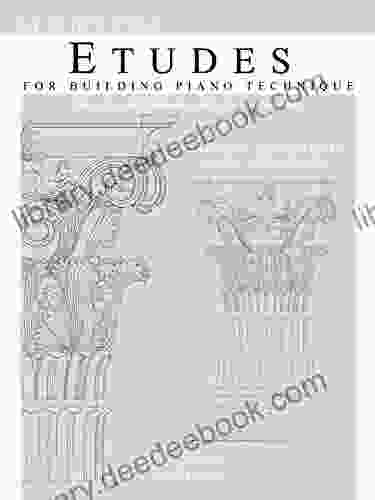Introducing Etudes: Building Blocks for Piano Technique

In the realm of piano playing, etudes hold a profound significance, acting as the cornerstone upon which pianists build their technical prowess and artistic expression. These meticulously crafted exercises, often composed by renowned masters, are designed to isolate and refine specific aspects of piano technique, enabling players to develop fluency, dexterity, and a profound understanding of the instrument's capabilities.
4.9 out of 5
| Language | : | English |
| File size | : | 7780 KB |
| Print length | : | 33 pages |
| Lending | : | Enabled |
| Screen Reader | : | Supported |
Etudes: A Historical Perspective
The origins of etudes can be traced back to the Baroque era, where composers such as Johann Sebastian Bach and Domenico Scarlatti created keyboard exercises known as "inventions" and "sonatas." These works, while not explicitly labeled as etudes, laid the groundwork for the development of the etude as a distinct genre.
In the 19th century, etudes emerged as an indispensable tool for piano pedagogy. Composers such as Carl Czerny and Franz Liszt dedicated themselves to writing extensive collections of etudes, each focusing on specific technical challenges and musical concepts. Czerny's "Complete Theoretical and Practical Piano Method" contains over 1,000 etudes, covering a vast range of technical skills.
The Romantic era witnessed the emergence of etudes that transcended their purely technical focus and became works of great musical beauty and expression. Frédéric Chopin's etudes, for instance, are renowned for their lyrical qualities, while Robert Schumann's "Symphonic Etudes" explore a wide range of musical textures and emotions.
Essential Elements of Etudes
Etudes are typically characterized by their emphasis on specific technical aspects, such as:
- Scales and Arpeggios: Etudes focusing on scales and arpeggios aim to improve finger dexterity, coordination, and evenness of touch.
- Octaves and Double Notes: These etudes develop strength, endurance, and independence in the fingers.
- Trills and Embellishments: Etudes involving trills and embellishments enhance finger agility and coordination.
- Rhythmic Variations: Etudes with complex rhythmic patterns improve timing, coordination, and the ability to maintain a steady tempo.
- Musical Expression: While technical proficiency is paramount, etudes can also foster musical expression through dynamic variations, phrasing, and articulation.
Benefits of Practicing Etudes
The benefits of incorporating etudes into one's piano practice are numerous and profound:
- Enhanced Finger Dexterity: Etudes challenge the fingers to perform intricate and rapid passages, improving their agility and coordination.
- Increased Strength and Endurance: The repetitive nature of etudes builds strength in the fingers, wrists, and forearms, enabling pianists to play for extended periods without fatigue.
- Refined Coordination: Etudes train the fingers to work together seamlessly, promoting balance and control.
- Improved Rhythmic Accuracy: The complex rhythmic patterns found in many etudes enhance timing and rhythmic precision.
- Enhanced Musical Expression: By mastering the technical aspects of piano playing, etudes free pianists to focus on musical interpretation and expression.
Incorporating Etudes into Practice
To effectively incorporate etudes into your practice routine, consider the following:
1. Start Slowly: Begin with etudes of moderate difficulty and gradually progress to more challenging ones as your technique improves.
2. Focus on Accuracy: Prioritize playing the notes correctly rather than at a fast tempo. Use a metronome to maintain a steady beat.
3. Practice Regularly: Consistency is key. Aim to practice etudes for a short duration every day rather than sporadic longer sessions.
4. Analyze the Music: Before playing, take some time to analyze the etude's structure, fingering, and rhythmic patterns. This will enhance your comprehension and improve your playing.
5. Seek Guidance: If possible, consult with a qualified piano teacher who can provide personalized guidance and feedback on your etude practice.
Etudes, the indispensable building blocks of piano technique, provide a wealth of benefits for pianists at all levels. By incorporating them into your practice routine, you can unlock greater technical proficiency, enhance musical expression, and embark on a transformative journey towards pianistic mastery.
4.9 out of 5
| Language | : | English |
| File size | : | 7780 KB |
| Print length | : | 33 pages |
| Lending | : | Enabled |
| Screen Reader | : | Supported |
Do you want to contribute by writing guest posts on this blog?
Please contact us and send us a resume of previous articles that you have written.
 Book
Book Novel
Novel Page
Page Genre
Genre E-book
E-book Magazine
Magazine Newspaper
Newspaper Paragraph
Paragraph Shelf
Shelf Glossary
Glossary Foreword
Foreword Synopsis
Synopsis Annotation
Annotation Manuscript
Manuscript Scroll
Scroll Classics
Classics Library card
Library card Narrative
Narrative Biography
Biography Memoir
Memoir Encyclopedia
Encyclopedia Narrator
Narrator Character
Character Librarian
Librarian Catalog
Catalog Borrowing
Borrowing Stacks
Stacks Periodicals
Periodicals Study
Study Research
Research Scholarly
Scholarly Reserve
Reserve Reading Room
Reading Room Rare Books
Rare Books Special Collections
Special Collections Study Group
Study Group Thesis
Thesis Dissertation
Dissertation Awards
Awards Book Club
Book Club Erich Hartfield
Erich Hartfield Barry M Shapiro
Barry M Shapiro Emma Broughton
Emma Broughton Laurie Gelman
Laurie Gelman David Loader
David Loader Sabrina Alexis
Sabrina Alexis Solomon Northup
Solomon Northup Becky Goldsmith
Becky Goldsmith Janet Malcolm
Janet Malcolm Benjamin Wittes
Benjamin Wittes Laura L Zimmerman
Laura L Zimmerman Liza Palmer
Liza Palmer Tony A Plate
Tony A Plate George Pullman
George Pullman Gareth Edwards
Gareth Edwards Greg Smalley
Greg Smalley Stephanie Hughes
Stephanie Hughes Katie Winters
Katie Winters Carlos Thions
Carlos Thions Mathsticks
Mathsticks
Light bulbAdvertise smarter! Our strategic ad space ensures maximum exposure. Reserve your spot today!

 Jackson HayesThe Not So Jolly Roger Time Warp Trio: A Voyage Through Time and Imagination
Jackson HayesThe Not So Jolly Roger Time Warp Trio: A Voyage Through Time and Imagination
 Jean BlairThe Lines We Leave Behind: Exploring the Profound and Enduring Legacy of Our...
Jean BlairThe Lines We Leave Behind: Exploring the Profound and Enduring Legacy of Our... Shane BlairFollow ·12.5k
Shane BlairFollow ·12.5k Virginia WoolfFollow ·18.8k
Virginia WoolfFollow ·18.8k Gil TurnerFollow ·13k
Gil TurnerFollow ·13k Garrett BellFollow ·13.9k
Garrett BellFollow ·13.9k Ed CooperFollow ·19.4k
Ed CooperFollow ·19.4k Caleb LongFollow ·3.4k
Caleb LongFollow ·3.4k Cason CoxFollow ·8.1k
Cason CoxFollow ·8.1k John SteinbeckFollow ·16k
John SteinbeckFollow ·16k

 Ralph Ellison
Ralph EllisonHealth Care Global Viewpoints: Samantha Whiskey
Samantha Whiskey is a global health...

 Gabriel Garcia Marquez
Gabriel Garcia MarquezTeacher Educators' Reflections on Culturally Relevant...
In today's...

 Levi Powell
Levi PowellSustainable Project Management: The GPM Reference Guide...
In today's rapidly changing world,...

 Isaac Bell
Isaac BellThe Captivating World of "Dreaming Awake Falling Under"
A Journey Through...

 Clarence Brooks
Clarence BrooksGovernance Regulations Valuations Mergers And...
In today's complex and ever-changing...
4.9 out of 5
| Language | : | English |
| File size | : | 7780 KB |
| Print length | : | 33 pages |
| Lending | : | Enabled |
| Screen Reader | : | Supported |










